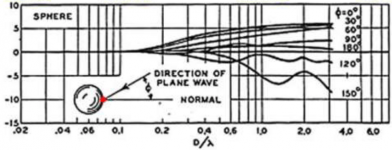Please take a good look at Olson's data for a sphere (see attached) which you now say you are specifically referring by asking:No, what I am saying is that possibly my post #16 in this thread is the answer to my own question. The question was, what is the sound pressure level directly behind the speaker relative to that directly in front of the speaker at the baffle step frequency? If the speaker system is closed- box by means of a sphere, then I think that the solution that I arrive at might be correct. But as I said, my understanding of acoustics is limited and I'm not the best at math either. Some checking that I have done seems to indicate that it holds water.
In Olson's data, notice that the line corresponding to 180 degrees (directly behind the sphere) is very close to but actually above the 0dB level? This shows that, directly behind the sphere, the level actually INCREASES thru the baffle step! Also note that a couple of other angles are below 0dB, namely 120 and 150 degrees (and via symmetry, 240 and 210 degrees)? It's these other angles are where the energy "comes from". These partial nulls are in between the side (e.g. 90) and rear (180) on each side.what is the sound pressure level directly behind the speaker relative to that directly in front of the speaker at the baffle step frequency?
When you say above:
you don't seem to be able to believe that you can be wrong about what you said in your post #16:what I am saying is that possibly my post #16 in this thread is the answer to my own question
No, the energy does not come from 180 degrees, what you call "directly behind the speaker".Any sound pressure added to the front wave must be pressure taken away from the rear wave.
